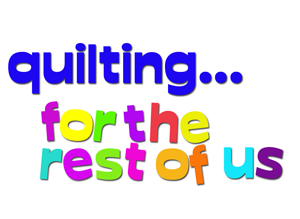We're heading off down a different Craftsy path today. I've reviewed a whole lotta quilting classes and a few foodie classes, but only one photography class so far.
But, oh, I've been hankering to do more photography classes on Craftsy. They have a lot of really good ones, but (1) they tend to be more expensive than the quilting classes and (2) I don't have a digital SLR (DSLR) camera, which is listed as required equipment for most classes. I do, however, have a camera that's basically only one step below the DSLR. I can't change out my lenses, but I can do most other things that DSLRs can do. So when Craftsy introduced a new photography class that lays the foundation, I bit: Basics of Digital Photography, with Rick Allred. (There was only one lesson specific to DSLRs, really, and that was a discussion of lenses. Otherwise I could do everything in all the lessons with my camera.)
Lesson on lighting--working with backlighting here
I wanted to brush up on what I'd learned in my high school photography class (using a darkroom n' all). I used to have an SLR camera in college and a few years beyond, and knew all that about f-stops and shutter speeds and the whole kettle of fish, but in the years since, when it got faster and easier to just whip out a point-and-shoot, and then (who'd have imagined?) my cell phone, I got lazy about it. With a big trip overseas on the horizon, it was time to re-learn what it means to do real photography.
Practicing shutter speed and aperture together
He starts out talking about your settings. Yes, it's necessary to have your users manual open at your side, unless you really know all those ins-and-outs of your camera. I've owned mine for a couple of years and have spent time with my manual, and still learned a ton about what my camera could do during that first lesson.
The next several lessons address the "exposure triangle"--ISO, aperture (f-stop), and shutter speed. His explanations are very easy to understand, and he has plenty of photographic examples to help you see the difference between settings. He gives homework suggestions in each lesson to give you some guidance about how to practice the techniques.
Working on panning. They were moving faster than I could, but this is an entertaining "mistake" picture.
After a lesson specific to lenses and filters (which I watched, even though it doesn't have immediate application--I hope to get a DSLR in the near future!), there are a couple of additional lessons, one on composition/creativity, that included some more settings to play with, and a final lesson on "putting it all together" which includes how to organize your photos, backing up, memory cards, comparing shots, and so forth.
I really enjoyed this class. Rick Allred is a good teacher--he uses great metaphors to explain fairly technical things. Again, I knew most of this back in the day but it's been (ahem) awhile, so though I wasn't quite coming at it cold, it was pretty chilly. I'm back to feeling like I actually know photography again!
Lesson on aperture and depth of field
This class wouldn't be particularly useful if you have no ability to change settings on your camera. Although he does talk about composition, most of the lessons do require the ability to have manual control to a degree. However, you may want to pull out your camera manual--you may have more control than you think you do! If you're able to set your aperture (f-stops) and shutter speeds at all, you'd get something out of this class. If you have a camera with more settings, you'd definitely learn a lot, and if you have a DSLR and are still figuring it out, I'd highly recommend this class.
Working with exposure compensation settings. And check out those quilts!
The Basics:
- 9 lessons, ranging from about 9 minutes to about 20 minutes
- Lessons include: "Get to Know Your Camera," Light and exposure, shutter speed, aperature, ISO, shooting modes, lenses, composition and creativity, and the final lesson named "putting it all together."
- Downloadable materials provide very helpful quick-reference materials. I've checked them a few times when it wasn't convenient to boot up the Craftsy class again.
Again, that's Basics of Digital Photography, with Rick Allred. Recommended!
(Transparency statement: Using the Craftsy links on this blog help support this blog and podcast. Thanks!)






